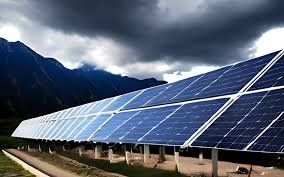As the frequency and intensity of natural disasters increase worldwide, the need for reliable and sustainable energy solutions becomes more pressing. Power outages during hurricanes, floods, wildfires, and other catastrophes can devastate communities and critical infrastructure. However, solar companies play an increasingly vital role in enhancing energy resilience in the face of these challenges. By offering decentralized and renewable energy sources, they help ensure that homes, businesses, and essential services remain operational when the traditional grid fails. We will explore how solar companies davis contribute to energy resilience during natural disasters.
Distributed Energy Solutions for Greater Flexibility
One of the most significant ways solar companies contribute to energy resilience during natural disasters is by promoting distributed energy solutions. Unlike centralized energy grids, which can be vulnerable to widespread damage during events like hurricanes or wildfires, distributed solar systems generate power locally. Typically installed on rooftops or smaller community-based arrays, these systems can continue functioning even when parts of the traditional grid are compromised. This is especially beneficial during natural disasters when large grid sections are offline for days or weeks.
Additionally, distributed solar systems often come equipped with battery storage options. Battery storage allows the excess energy produced by solar panels during normal operation to be stored and used later, even when the sun is not shining. In the case of a natural disaster, these batteries can provide vital backup power, keeping lights on, communications operational, and critical systems like refrigeration and medical devices running. Solar companies are increasingly offering integrated solar and storage solutions, ensuring that communities are not solely reliant on grid power during emergencies.
Minimizing Vulnerability Through Microgrids
Another important contribution of solar companies to energy resilience is their role in developing and implementing microgrids. Microgrids are small-scale energy networks that can operate independently of the central grid. Powered by solar energy and sometimes coupled with other renewable sources like wind or hydropower, microgrids provide a localized energy solution that is less vulnerable to widespread blackouts. Microgrids can ensure that essential services—such as hospitals, emergency shelters, and water treatment facilities—remain operational during a natural disaster.
Solar companies can help design and deploy microgrids tailored to specific needs by working with local governments and communities. These systems provided a lifeline for communities without grid power for months. As more regions face natural disasters with increasing frequency, solar-powered microgrids are becoming a viable solution for ensuring energy resilience.
Environmental Benefits and Disaster Recovery
Solar energy’s contributions to energy resilience during natural disasters go beyond keeping the lights on—they also support environmental recovery efforts. Fossil fuel-based generators are a common fallback during power outages, but they produce harmful emissions that can exacerbate air quality issues, particularly during wildfires. Solar companies offer a cleaner alternative, reducing the reliance on gas-powered generators and minimizing the environmental impact of recovery efforts.
Furthermore, solar panels are relatively durable and can withstand harsh weather conditions. Many systems are designed to endure high winds and debris impact, making them more resilient in hurricanes and storms. Solar companies continuously improve their technologies to enhance the durability and longevity of solar installations, ensuring that they remain functional even in disaster-prone areas. This durability, combined with the environmental benefits of reducing emissions during recovery efforts, highlights solar energy’s role in promoting sustainability even in the aftermath of natural disasters.
Addressing Energy Equity and Access
A crucial yet often overlooked aspect of energy resilience is ensuring that vulnerable and underserved communities can access reliable energy during natural disasters. Solar companies are playing a growing role in addressing energy equity by working with government programs, non-profits, and community organizations to bring solar power to low-income neighborhoods, rural areas, and regions that lack access to the traditional energy grid. These communities are often the hardest hit by natural disasters and the slowest to recover due to their limited access to reliable energy.
Solar companies are working to close this gap by offering affordable solar options, grants, and financing models that allow these communities to invest in renewable energy systems. Moreover, solar energy’s decentralized nature means that remote and off-grid areas can achieve energy independence without relying on vulnerable and aging grid infrastructure. In the aftermath of a natural disaster, solar power can provide a lifeline for these underserved communities, offering an opportunity to rebuild more resilient and sustainably.
Solar companies are increasingly essential in enhancing energy resilience during natural disasters. By promoting distributed energy solutions, developing microgrids, and contributing to environmental recovery efforts, they offer reliable and sustainable alternatives to the traditional power grid. Moreover, solar companies are addressing energy equity issues and working with governments and disaster response agencies to ensure that communities can access renewable energy, especially during emergencies. As the world faces more frequent and severe natural disasters, solar energy will continue to be critical in building resilient, sustainable, and equitable energy systems. By embracing the innovations provided by solar companies, societies can better withstand the impacts of natural disasters and recover more effectively in their aftermath.

